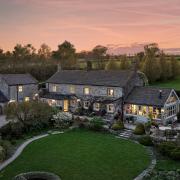Batley is enjoying a fresh lease of life, thanks to a new breed of entrepreneur and once again it is being driven by the mills as Terry Fletcher reports Photographs by John Cocks
The years may not have always been kind to Batley yet it is still impossible to stand in the market place and not recognise that this was once a very prosperous community bursting with civic pride and ambition. Arrayed around the gently sloping setts is a collection of handsome buildings to rival those to be found anywhere.
The imposing town hall is self-confidence made stone, fronted with solid pillars supporting a huge neo-classical pediment that says here is a town to be reckoned with. It is rivalled only by the imposing Carnegie Library and Art Gallery, across the square. Thanks to its elevated position and a crowning two-storey-high clock tower it can still manage to look down on its grand companion. They and their neighbours, once blackened with the soot from thousands of coal fires and dozens of factories and mills, have been cleaned up in recent years to reveal golden fa�ades and carving hidden beneath the grime.
Batley was recorded in William the Conqueror’s Domesday Book but little remains from Norman times. Instead these buildings mainly date from the turn of the 19th century when Batley was a world leader in cloth production and the title of ‘the shoddy capital’ was a boast rather than a gift to comedians looking for a cheap laugh. Shoddy is a woollen cloth made by shredding rags and then mixing the resultant fibre with virgin wool to create textiles for blankets and uniforms. The process was perfected by a string of northern entrepreneurs and Batley boomed.
Another legacy from that Victorian heyday is to be found just outside the town centre. The magnificent Bagshaw Museum, which stands in Wilton Park overlooking the ornamental lake, was once the home to George Sheard, one of the ‘shoddy barons’ who ruled the roost in this part of the West Riding.
But in the second half of the 20th century the textile industry, battered by cheap imports, collapsed and Batley, along with many other communities in the once-dominant Yorkshire Heavy Woollen District slumped. Now, however, the town is enjoying a fresh lease of life, thanks to a new breed of entrepreneur and once again it is being driven by the mills. This time, however, it is not the clanking of carding machines and the clattering of looms that provide the soundtrack to the renaissance but the ringing of tills. And there’s nothing shoddy about this retail revolution.
Thanks to a combination of visionary investment and Batley’s position at the centre of the M62 corridor it has become a top-flight shopping destination, drawing in customers from as far afield as Liverpool, Manchester and Hull.
The first signs of this are on the motorway itself where the vast IKEA store is at the heart of a huge retail complex. But the real gems are to be found in Batley itself and they came about largely thanks to the zeal of one man. If Stephen Battye had been created as fiction he would have been dismissed as a clich�. An 11-plus failure, he managed to get a place to study textile design as Batley Art College. During his holidays he earned money by painting walls at a mill, picked up some off-cuts of cloth, learned to print on them, started his own business and eventually bought the mill.
With two other ex-Batley students he created the textile company Skopos, building it up to an �18m a year business by the mid-1990s. They sold and later bought back the mill, this time converting it into retail units. But this was no ‘pile-it-high-sell-it-cheap’ mill shop, such as popped up all across the North. This was to be top quality products and design.
Some scoffed at the idea of Batley as the showcase for high class design but The Mill proved a huge success and was followed by a second, Red Brick Mill, which is home to five caf�s and restaurants and some of the poshest names in UK furniture and design.
Andrew Sloman, Batley’s town centre manager, said: ‘Stephen died in 2010 but he was responsible for a huge change in the town. He looked at these grand old mills and saw their potential and now they are bringing people in from right across the region.
‘Yet throughout it all we’ve managed to retain our town centre too with local shops and the Friday market. As the (Mary) Portas report showed many places are losing their hearts to out of town shopping and the internet but Batley’s is still here and our market is actually growing with the number of stalls increasing.’
Getting there: Batley is seven miles south of Leeds and Bradford and easily reached from the M62 motorway. Trains run from Leeds and Manchester.
Parking: Free on-street parking and in the Market Place.
What to do: Great shopping in the mills or admire the Victorian buildings around the town centre.


























